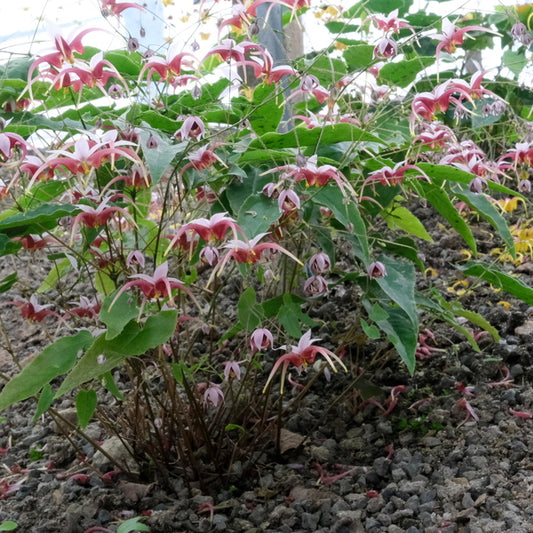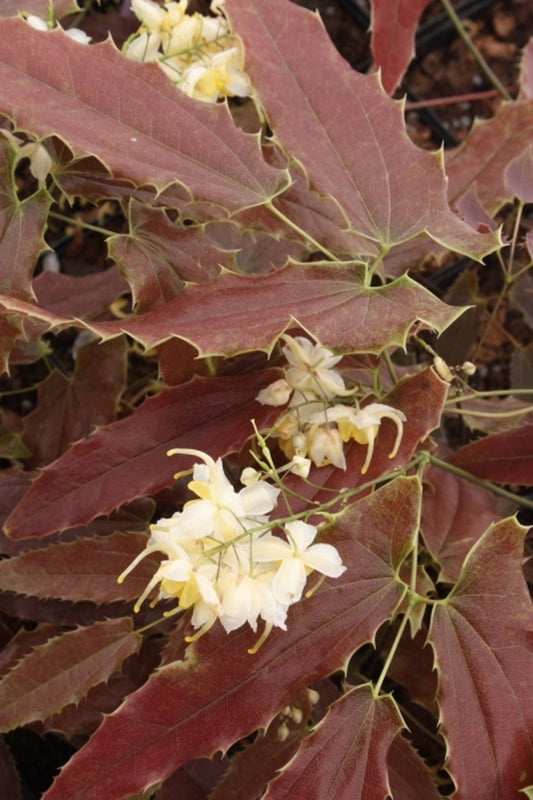Thanks to Epimedium guru Darrell Probst for helping us get our offerings off the ground and correctly identified. Thanks to Darrell, Plant Delights Nursery now has one of the best collections of Epimedium for sale anywhere. Epimedium species will never be traffic stoppers like roses, but these woodland shade perennials are the unsung workhorses that tie the shade garden together.
-
Epimedium 'Amber Queen'
Item #: 8191
Zones: 5a to 8b, at least
Dormancy: Winter
Height: 24" tall
Culture: Part Sun to Light Shade
Origin: Hybrid
Pot Size: 3.5" pot (24 fl. oz/0.7 L)
Regular price $30.00Regular priceUnit price per -
Epimedium 'Cherry Blossom'
Item #: 8486
Zones: 5a to 8b, at least
Dormancy: Winter
Height: 18" tall
Culture: Light Shade
Origin: Hybrid
Pot Size: 3.5" pot (24 fl. oz/0.7 L)
Regular price $32.00Regular priceUnit price per -
Epimedium 'Domino'
Item #: 8493
Zones: 5a to 8b, at least
Dormancy: Evergreen
Height: 24" tall
Culture: Part Sun to Light Shade
Origin: Hybrid
Pot Size: 3.5" pot (24 fl. oz/0.7 L)
Regular price $32.00Regular priceUnit price per -
Epimedium 'Golden Angels'
Item #: 14840
Zones: 5b to 8b, guessing
Dormancy: Winter
Height: 18" tall
Culture: Part Sun to Light Shade
Origin: Hybrid
Pot Size: 3.5" pot (24 fl. oz/0.7 L)
Regular price $29.00Regular priceUnit price per -
Epimedium 'Hugs and Kisses'
Item #: 17845
Zones: 5a to 8b, at least
Dormancy: Evergreen
Height: 12" tall
Culture: Part Sun to Light Shade
Origin: Hybrid
Pot Size: 3.5" pot (24 fl. oz/0.7 L)
Regular price $32.00Regular priceUnit price per -
Epimedium 'Lyrical Lemonade'
Item #: 16678
Zones: 5a to 8b, guessing
Dormancy: Winter
Height: 16" tall
Culture: Part Sun to Light Shade
Origin: Hybrid
Pot Size: 3.5" pot (24 fl. oz/0.7 L)
Regular price $29.00Regular priceUnit price per -
Epimedium 'Ninja Stars' PP 29,744
Item #: 15561
Zones: 5a to 8b, at least
Dormancy: Evergreen
Height: 15" tall
Culture: Part Sun to Light Shade
Origin: Hybrid
Pot Size: 3.5" pot (24 fl. oz/0.7 L)
Regular price $38.00Regular priceUnit price per -
Epimedium x perralchicum 'Frohnleiten'
Item #: 2984
Zones: 5b to 8b, at least
Dormancy: Evergreen
Height: 15" tall
Culture: Part Sun to Light Shade
Origin: Hybrid
Pot Size: 3.5" pot (24 fl. oz/0.7 L)
Regular price $30.00Regular priceUnit price per -
Epimedium 'Pink Champagne'
Item #: 8936
Zones: 5a to 8b, at least
Dormancy: Evergreen
Height: 24" tall
Culture: Part Sun to Light Shade
Origin: Hybrid
Pot Size: 3.5" pot (24 fl. oz/0.7 L)
Regular price $35.00Regular priceUnit price per -
Epimedium 'Rise and Shine'
Item #: 12757
Zones: 5a to 8b, at least
Dormancy: Evergreen
Height: 12" tall
Culture: Part Sun to Light Shade
Origin: Hybrid
Pot Size: 3.5" pot (24 fl. oz/0.7 L)
Regular price $38.00Regular priceUnit price per -
Epimedium 'Spring Sunrise'
Item #: 14841
Zones: 6a to 8b, possibly colder
Dormancy: Evergreen
Height: 32" tall
Culture: Part Sun to Light Shade
Origin: Hybrid
Pot Size: 3.5" pot (24 fl. oz/0.7 L)
Regular price $35.00Regular priceUnit price per -
Epimedium x versicolor 'Versicolor'
Item #: 5124
Zones: 5a to 8b
Dormancy: Winter
Height: 14" tall
Culture: Part Sun to Light Shade
Origin: Hybrid
Pot Size: 3.5" pot (24 fl. oz/0.7 L)
Regular price $30.00Regular priceUnit price per -
Epimedium 'Woodland Elf' PPAF
Item #: 17846
Zones: 5a to 8b, guessing
Dormancy: Winter
Height: 24" tall
Culture: Part Sun to Light Shade
Origin: Hybrid
Pot Size: 3.5" pot (24 fl. oz/0.7 L)
Regular price $35.00Regular priceUnit price per -
Epimedium wushanense 'Royal Dress'
Item #: 17967
Zones: 6a to 8b, possibly colder
Dormancy: Evergreen
Height: 10" tall
Culture: Part Sun to Light Shade
Origin: China
Pot Size: 3.5" pot (24 fl. oz/0.7 L)
Regular price $35.00Regular priceUnit price per -
Epimedium wushanense 'Sandy Claws'
Item #: 8861
Zones: 6a to 8b, possibly colder
Dormancy: Evergreen
Height: 12" tall
Culture: Part Sun to Light Shade
Origin: China
Pot Size: 3.5" pot (24 fl. oz/0.7 L)
Regular price $32.00Regular priceUnit price per -
Epimedium 'Yellowstone'
Item #: 15560
Zones: 5a to 8b, guessing
Dormancy: Winter
Height: 20" tall
Culture: Part Sun to Light Shade
Origin: Hybrid
Pot Size: 3.5" pot (24 fl. oz/0.7 L)
Regular price $35.00Regular priceUnit price per
More Information About Epimedium
Epimediums are easy-to-grow perennial wildflowers. They are tenacious flowering shade plants that provide a welcome first breath of spring with their airy flowers, then a solid backdrop of attractive foliage for the remainder of the growing season. Epimedium plants are used either as woodland garden specimens or groundcovers for small shady areas. As a bonus, epimediums are deer resistant.
Epimedium Varieties
We are thrilled to be able to offer several exceedingly rare epimedium plants for sale to the public that were only recently discovered and named from remote regions of Asia, along with fabulous hybrids like Epimedium youngianum and Epimedium 'Frohnleiten'. Epimedium flowers are small (largest is Epimedium grandiflorum) but profuse and colorful with colors ranging from white to yellow (Epimedium sulphureum), pink/red (Epimedium rubrum) and bi-colored (Epimedium epsteinii and Epimedium accuminatum). Newly emerging epimedium foliage often has purple or brown tones or patterns which complement the flowers.
Medicinal Uses
Epimedium plants are used in traditional Chinese medicine as a treatment for a variety of medical conditions including fatigue, arthritic pain, and nerve pain. Around the world, men also buy epimedium plants to use as an herbal supplement under the name, 'horny goat weed'. Guess what it is purported to do!
Companion Plants
Try pairing with other plants with silly animal names like Bergenia (Pigsqueak), Chelone (Turtlehead), Acanthus (Bear's Breech), Cimicifuga (Bugbane) and Silene (Catchfly) to create a botanical menagerie of fun.
Other Common Names
Epimedium is known by a variety of common names including fairy wings, barrenwort, bishop’s hat, and yes, horny goat weed.
How to Grow and Care for Epimedium Plants
When to Plant
Most varieties of can be planted anytime from late spring once the threat of frost has passed, to early fall.
Where to Plant
Epimediums are known as great dry shade plants but are often found growing next to woodland waterfalls in the wild. We recommend part sun to light shade with a rich, moisture retentive soil. Think woodland setting with dappled light. Plant about 12 in. (30 cm.) apart and they will eventually grow together filling the space.
Water and Soil Requirements
Most epimediums prefer a neutral to slightly acidic soil. Most important is good drainage. Water new plants regularly until they are well established.
Epimedium Flowering Times
Most species are spring flowering. Flowering times range between early March to early May here in NC (zone 7b). See our list of relative epimedium flowering times for more precise information.
Fall/Winter Care
It is completely acceptable to trim the old foliage in late winter to make room for new leaves in the spring and to encourage additional flowering.
Pests and Diseases
Epimedium are resistant to most pests and diseases, including deer and rabbit, but can be susceptible to some plant viruses and root nematode.
Propagating Epimedium Plants
Epimediums spread via a rhizome (woody, underground plant stem) and can be divided once flowering has finished. Always leave about two-thirds of the foliage on the newly divided plant to encourage new root development.
Landscape Usage
Epimedium are one of the few perennials that can tolerate dry shade, so this really expands the possibilities in your woodland themed garden. We like using as a border plant on a woodland trail or as ground cover in a mixed shade woodland garden.
Plant Delights Nursery has a large selection of exceedingly rare epimedium plants for sale. Check out our in-depth article about fairy wings for more tips on successfully growing and caring for epimedium. Be sure to also read our many epimedium blog posts over at the JBLG.org blog.




















